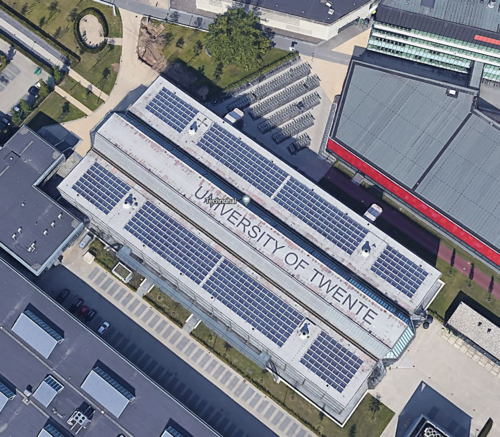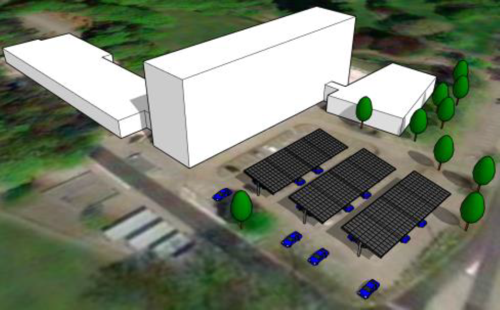University of Twente is continually working to make the organisation more sustainable. It is our mission to respond to societal needs by developing sustainable, proactive measures to support our planet and the people who live on it. We are dedicated to environmental, social and economic sustainability in our education, research, innovation and the way we run our own organisation. Many ongoing initiatives in this area can be found here.
An important development on which UT is currently focusing is saving on energy consumption. Some examples include lowering the temperature for our heating, utilising all possibilities to reduce the energy used by our technical installations and asking people to consciously turn lights off when not required. In addition, we are also focusing on increasing the number of solar panels on campus.
Solar panels on current UT buildings
When existing buildings undergo renovation, it is logical to investigate whether the load-bearing capacity of the roof is sufficient and whether the incidence of sunlight is suitable for solar panels. During a renovation, the roof insulation and roofing are almost always replaced, making it an opportune time to add solar.
For example, a few years ago, 624 solar panels were installed on the roof of the Technohal (TechMed Centre). There are 73 panels on the Drienerburght building. In 2023, 916 solar panels will be installed on the Langezijds building (which will soon house ITC). The Citadel building is also in line for panels.

In 2013, UT already installed 120 panels on the Noordhorst building. These have been functioning smoothly and have delivered 252 MWh since installation.
In total, the current panels produce approximately 530 MWh per year and thus cover 2.5% of the annual consumption of the UT (21,000 MWH).
The aim is to further expand the number of solar panels in the coming period. It makes sense to install solar panels on existing buildings whose roofing and insulation do not need to be replaced in the short term. In addition, many roofs on campus do not receive sufficient sunlight because they are in the shade of trees, making them unsuitable.
The following roofs are now under review:
- Sports Centre. A detailed construction analysis of the roof load is currently being carried out. In addition, the fire resistance of insulation and roofing is being investigated. If the fire resistance does not meet our insurers' conditions, a building with solar panels can no longer be insured and the installation of panels is not possible.
- A detailed construction analysis is being carried out for Carré and Nanolab.
- For the Citadel building, the research into the roof load and fire safety has shown positive results and, therefore, the location is appropriate for the installation of panels.
Panels in parking lots
In collaboration with the municipality of Enschede, UT is investigating whether there are parking areas on campus that are suitable to become covered parking lots, in order to subsequently install solar panels on the roof. Car charging facilities would also be able to be connected to the panels in these areas. We are currently looking at the possibility of doing this at parking lot P4 and the parking lot in front of the Spiegel building. These parking areas are appropriately located in relation to the sun and are not shaded.

In the parking lot in front of the Spiegel there is room for 435 panels on a new roof that would cover the carpark area, which would generate an estimated 160 MWh per year. This corresponds to the average electricity consumption of approximately 65 households. The CO2 emission reduction would be 89 tonnes per year.
At P4, after the addition of a roof, there would be room for 1000 panels with an expected energy yield of 368 MWH per year. This is the power consumption of approximately 145 households. The reduction of CO2 emissions for this project would be 204 tonnes per year.
Both enclosures have a reasonable payback period of 8 years without taking any subsidy into account.
However, a study on the future development possibilities of the campus was recently launched. It may be that a different function for car park P4 will emerge from this. The Executive Board is awaiting the outcome before making a decision on adding roofs to the car parks.
Together with the current solar panels on UT roofs and with the realisation of solar panels on both parking lots, the yield from the sun would be 1,058 MWh per year, 5% of the total electricity consumption on campus. If the roofs currently under investigation are also suitable for panels, total generation could rise to 7% of consumption.





